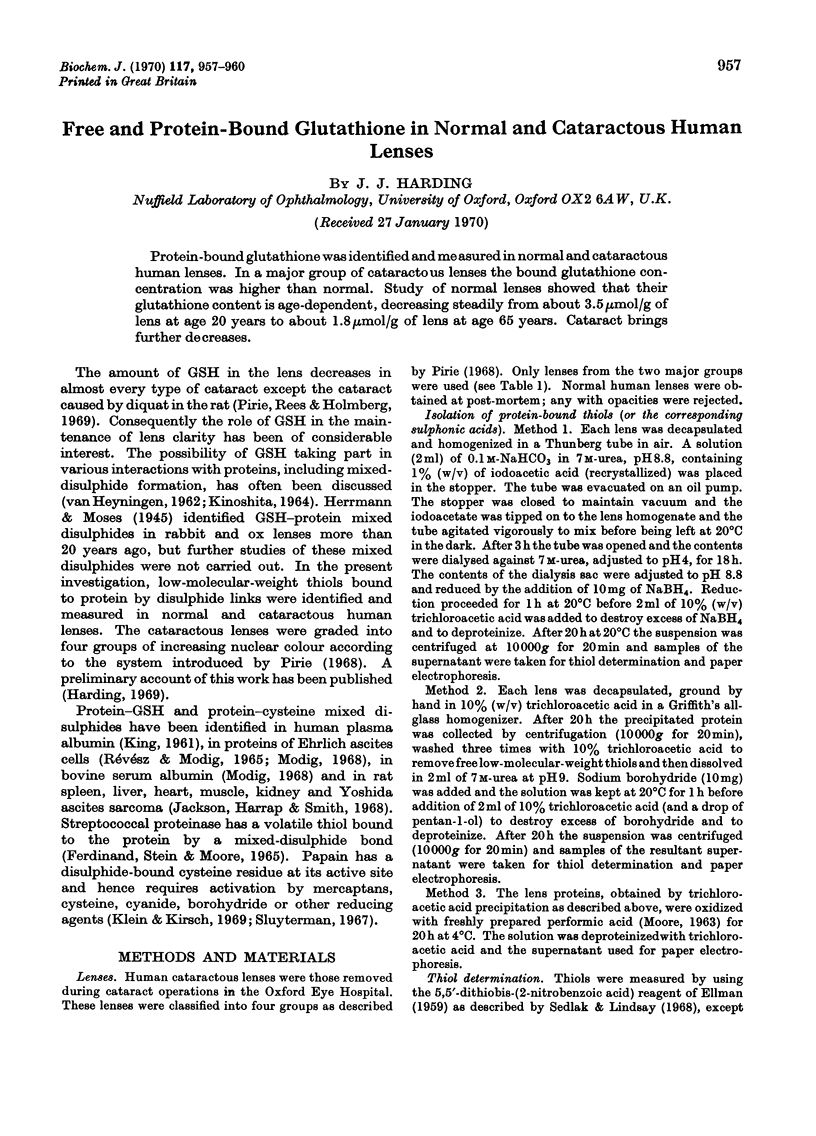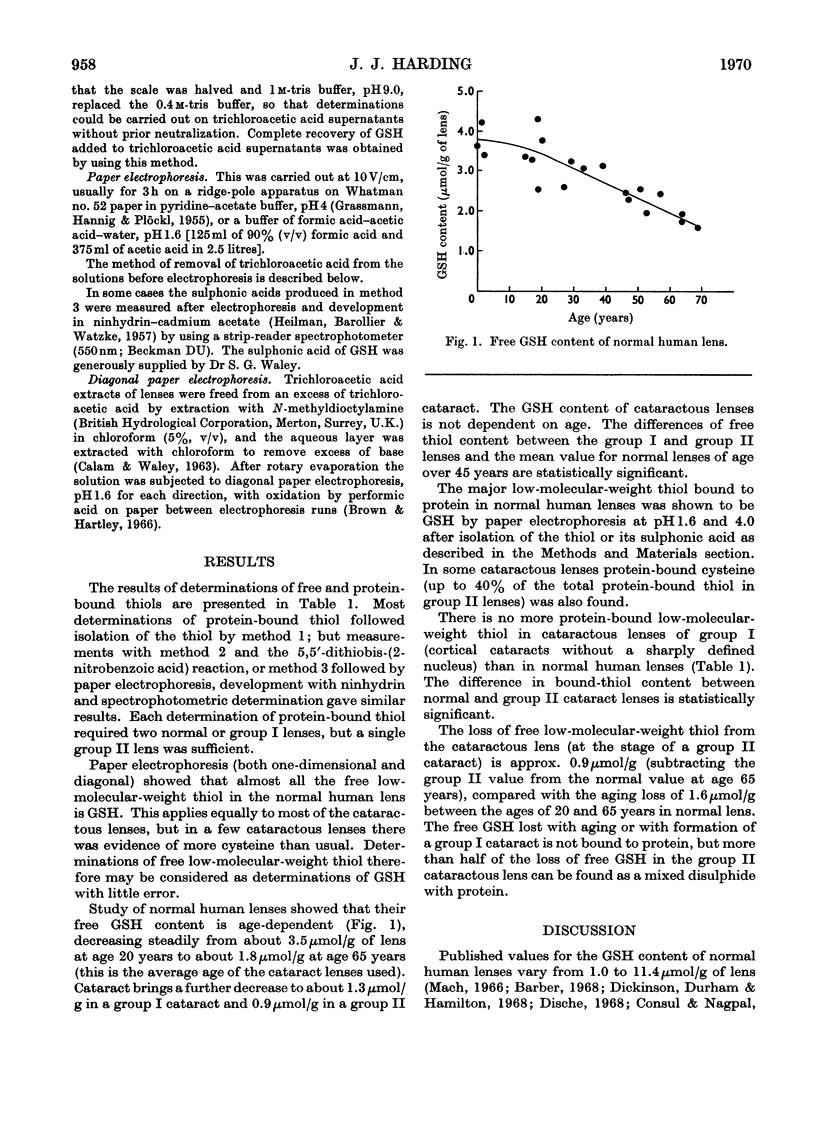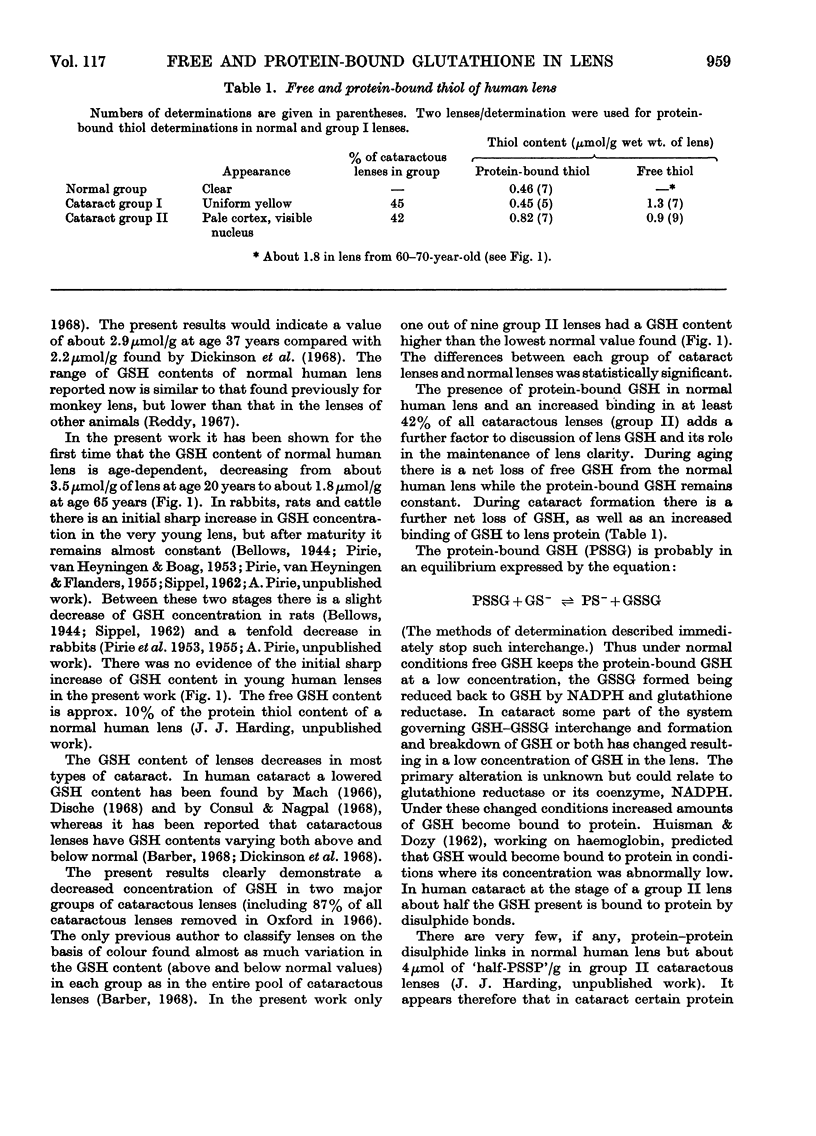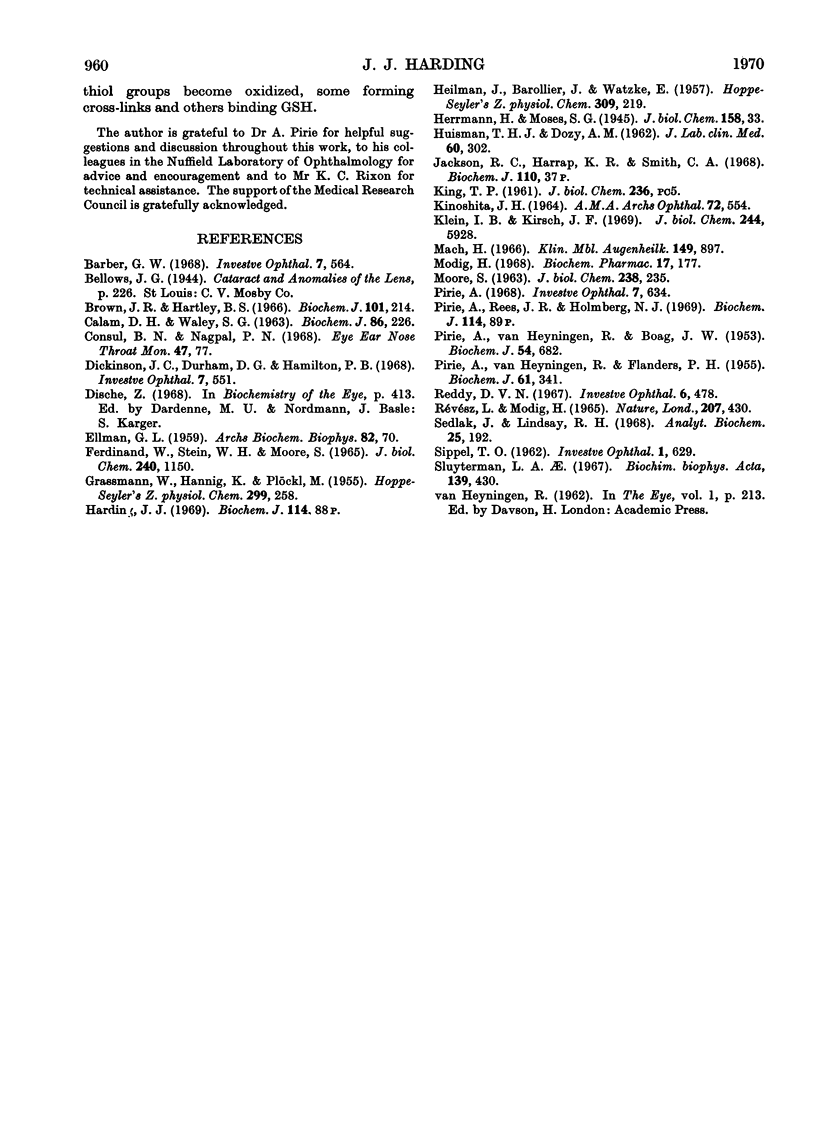Abstract
Protein-bound glutathione was identified and measured in normal and cataractous human lenses. In a major group of cataracto us lenses the bound glutathione concentration was higher than normal. Study of normal lenses showed that their glutathione content is age-dependent, decreasing steadily from about 3.5μmol/g of lens at age 20 years to about 1.8μmol/g of lens at age 65 years. Cataract brings further decreases.
Full text
PDF



Selected References
These references are in PubMed. This may not be the complete list of references from this article.
- Brown J. R., Hartley B. S. Location of disulphide bridges by diagonal paper electrophoresis. The disulphide bridges of bovine chymotrypsinogen A. Biochem J. 1966 Oct;101(1):214–228. doi: 10.1042/bj1010214. [DOI] [PMC free article] [PubMed] [Google Scholar]
- CALAM D. H., WALEY S. G. Acidic peptides of the lens. 8. S-(alpha beta-dicarboxyethyl) glutathione. Biochem J. 1963 Feb;86:226–231. doi: 10.1042/bj0860226. [DOI] [PMC free article] [PubMed] [Google Scholar]
- Dickinson J. C., Durham D. G., Hamilton P. B. Ion exchange chromatography of free amino acids in aqueous fluid and lens of the human eye. Invest Ophthalmol. 1968 Oct;7(5):551–563. [PubMed] [Google Scholar]
- FERDINAND W., STEIN W. H., MOORE S. AN UNUSUAL DISULFIDE BOND IN STREPTOCOCCAL PROTEINASE. J Biol Chem. 1965 Mar;240:1150–1155. [PubMed] [Google Scholar]
- GRASSMANN W., HANNIG K., PLOCKL M. Eine Methode zur quantitativen Bestimmung der Aminosäurezusammensetzung von Eiweisshydrolysaten durch Kombination von Elektrophorese und Chromatographie. Hoppe Seylers Z Physiol Chem. 1955;299(5-6):258–276. [PubMed] [Google Scholar]
- HEILMANN J., BARROLLIER J., WATZKE E. Beitrag zur Aminosäurebestimmung auf Papierchromatogrammen. Hoppe Seylers Z Physiol Chem. 1957;309(4-6):219–220. [PubMed] [Google Scholar]
- HUISMAN T. H., DOZY A. M. Studies on the heterogeneity of hemoglobin. V. Binding of hemoglobin with oxidized glutathione. J Lab Clin Med. 1962 Aug;60:302–319. [PubMed] [Google Scholar]
- KINOSHITA J. H. SELECTED TOPICS IN OPHTHALMIC BIOCHEMISTRY. Arch Ophthalmol. 1964 Oct;72:554–572. doi: 10.1001/archopht.1964.00970020554022. [DOI] [PubMed] [Google Scholar]
- Klein I. B., Kirsch J. F. The activation of papain and the inhibition of the active enzyme by carbonyl reagents. J Biol Chem. 1969 Nov 10;244(21):5928–5935. [PubMed] [Google Scholar]
- Mach H. Untersuchungen von Linseneiweiss und Glutathion und Mikroelektrophorese von wasserlöslichem Eiweiss im Zuckerstar (Cataracta diabetica) Klin Monbl Augenheilkd. 1966;149(6):897–904. [PubMed] [Google Scholar]
- Modig H. Cellular mixed disulphides between thiols and proteins, and their possible implication for radiation protection. Biochem Pharmacol. 1968 Feb;17(2):177–186. doi: 10.1016/0006-2952(68)90321-3. [DOI] [PubMed] [Google Scholar]
- PIRIE A., VAN HEYNINGEN R., BOAG J. W. Changes in lens during the formation of x-ray cataract in rabbits. Biochem J. 1953 Jul;54(4):682–688. doi: 10.1042/bj0540682. [DOI] [PMC free article] [PubMed] [Google Scholar]
- PIRIE A., VAN HEYNINGEN R., FLANDERS P. H. Changes in lens during the formation of x-ray cataract in rabbits. III. Phosphates. Biochem J. 1955 Oct;61(2):341–347. doi: 10.1042/bj0610341. [DOI] [PMC free article] [PubMed] [Google Scholar]
- Révész L., Modig H. Cysteamine-induced increase of cellular glutathione-level: a new hypothesis of the radioprotective mechanism. Nature. 1965 Jul 24;207(995):430–431. doi: 10.1038/207430a0. [DOI] [PubMed] [Google Scholar]
- SIPPEL T. O. Respiration and glutathione in the growing rat lens. Invest Ophthalmol. 1962 Oct;1:629–634. [PubMed] [Google Scholar]
- Sedlak J., Lindsay R. H. Estimation of total, protein-bound, and nonprotein sulfhydryl groups in tissue with Ellman's reagent. Anal Biochem. 1968 Oct 24;25(1):192–205. doi: 10.1016/0003-2697(68)90092-4. [DOI] [PubMed] [Google Scholar]
- Sluyterman L. A. The activation reaction of papain. Biochim Biophys Acta. 1967 Jul 11;139(2):430–438. doi: 10.1016/0005-2744(67)90046-0. [DOI] [PubMed] [Google Scholar]


